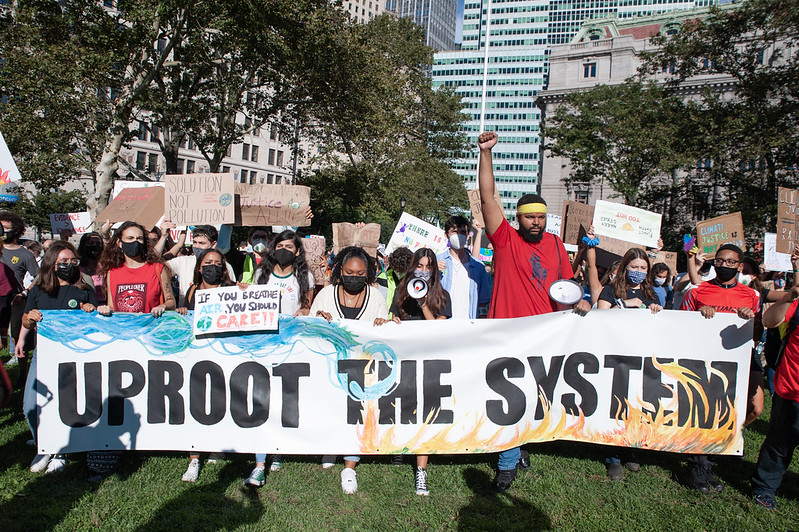Erika Kessler (elk2144@tc.columbia.edu)
Oren Pizmony-Levy (op2183@tc.columbia.edu)
Children and youth activism in New York City is not new. Since the late 1800s, young people have led strikes for labor rights and access to schooling across the five boroughs. The impact of young people’s actions for social change is woven through the fabric of New York City history. Indeed, one of the largest civil rights demonstrations in the US was in 1963 when over 360,000 elementary, middle, and high school students boycotted schools and attended freedom schools in the city. The rich history of student activism in New York City continues today. We are seeing a surge of political activism by youth across the realities and issues we now face, including the impacts of climate change and climate injustice.
Climate change threatens the present and future sustainability of our planet. It has already impacted people and the environment around the world, exacerbating social, economic, and racial inequality across generations. Scientists agree the Earth’s climate is changing and humans are the primary cause of this development. International collective action and cooperative measures at all levels are needed to address the impacts of climate change through adaptation and mitigation efforts.
Intensifying urgency to address our climate crisis, it comes as no surprise that anxious and frustrated young people are protesting about climate inaction. The contemporary youth climate movement (also known as the Student Strike 4 Climate, Fridays for Future, or the Youth Strike 4 Climate) burst forth, in 2018, calling for widespread climate action by protesting and striking schools. The youth climate movement is actively seeking to mobilize youth and adults in acting for climate justice, which include the intersection of climate change and social inequality. Although youth climate activism is not a new phenomenon, the magnitude of youth voices about climate change is growing and New York City has played a central site for amplifying their calls.
This youth movement, although expansively transnational, holds a strong presence in New York City. In 2019, students and climate activists coordinated, along with hundreds of other cities, one of the world’s largest international protests. The New York City Department of Education even gave permission for youth to skip school for the day and strike. An estimated 250,000 people participated in the strikes and rallies across New York City in the 2019 week of Global Climate Strikes. Youth climate activists in New York City continue a wide variety of collective action throughout the city. Some are working with the NYC Department of Education Sustainability Office. Others are founding their own organizations and nonprofits aiming at addressing climate change (see for example, Kids fight Climate Change, Earth Uprising, XR Youth NYC, Fridays for Future NYC, Sunrise Movement NYC Youth).
Recently, in New York City, more than 2,000 students and climate activists participated in the Global Climate Strike on September 24, 2021, which was organized by the local chapter of Fridays For Future, a youth-led climate-advocacy group, during Climate Week NYC 2021. On that day, children, youth and adults took to the streets calling to #UprootTheSystem and highlight how climate change disproportionately impacts people and areas in the global south. The movement’s message aims to amplify and fight alongside MAPA (Most Affected Peoples and Areas) voices to demand leaders and the Global North to cut emissions and enact strong measures to address climate injustice.
To better understand and document who participated in the September 24 th Global Climate Strike in New York City, we coordinated a flash survey of strike participants. We trained a team of 12 graduate students from Teachers College (ITSF 5031) and visiting students from the Kibbutzim College, Israel on a crowd sampling protocol. The team joined the strike near City Hall and
conducted a brief survey with strikers.
The survey was developed based on a pilot study conducted in Spring 2021 with youth climate activists, as part of the Youth at the Center Initiative at the Center for Sustainable Futures, Teachers College. The survey included 18 questions on demographics, past participation in climate strikes, affiliation to and contact with organizations, experiences in school, and emotions about the climate crisis. The final sample includes 203 respondents.
Detailed findings from the flash survey are available here. Participants were high school and college students, with the average age being 16. The majority of the participants were women (70%). About half (49%) of the respondents identified as people of color. Over half (54%) participated in school climate strikes before the event, yet three out of four did not identify any organization that contacted them to participate in the strike. Those who were contacted by organizations named Fridays for Future NYC, Sunrise and Our Climate as organizations they were affiliated with; these organizations are also the primary organizers of the strike, most central being Fridays for Future.
Overall, we find that participants report learning about climate change and activism in their classrooms and feel supported in participating in climate action. Echoing other studies on emotional response to the climate crisis, we heard from participants that they are largely anxious, frustrated, fearful, and sad. We do find that their range of anxieties and frustration are also linked to feelings of hopefulness and determination. We argue that these feelings are just as crucial to untangle when considering the link between climate change and emotion.
